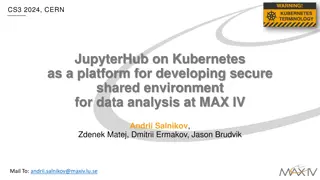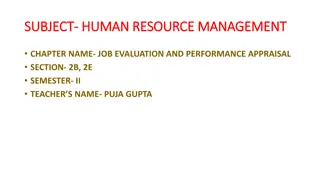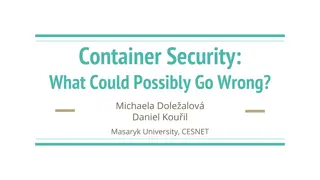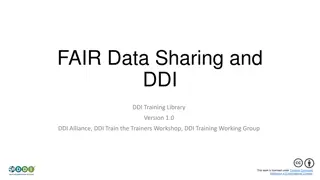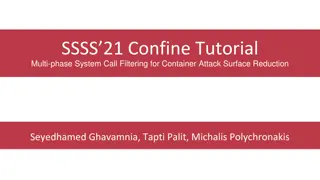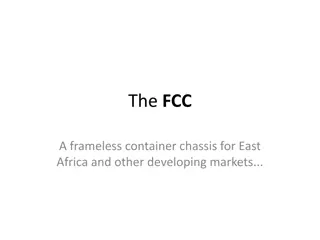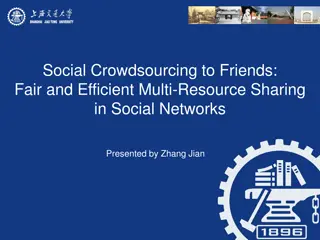Container-Based Job Management for Fair Resource Sharing
Resource contention in multicore systems is a significant issue that can be addressed through techniques like resource isolation models and resource containers. While these technologies offer benefits in managing resource allocation, they also present challenges in job scheduling and interaction with external tools. Understanding how resource containers work and their implications is crucial for optimizing resource utilization in a fair manner.
Download Presentation

Please find below an Image/Link to download the presentation.
The content on the website is provided AS IS for your information and personal use only. It may not be sold, licensed, or shared on other websites without obtaining consent from the author.If you encounter any issues during the download, it is possible that the publisher has removed the file from their server.
You are allowed to download the files provided on this website for personal or commercial use, subject to the condition that they are used lawfully. All files are the property of their respective owners.
The content on the website is provided AS IS for your information and personal use only. It may not be sold, licensed, or shared on other websites without obtaining consent from the author.
E N D
Presentation Transcript
Container-Based Job Management for Fair Resource Sharing Jue Hong, Pavan Balaji, Gaojin Wen, Bibo Tu, Junming Yan, Chengzhong Xu, and Shengzhong Feng Oracle Corporation Argonne National Laboratory Chinese Academy of Sciences Tencent Inc.
Resource Isolation Requirements Resource contention is a big problem in multicore systems Memory, network, shared caches As systems become fatter (node core-count wise), this is going to continue to be a problem Techniques to isolate each OS process into a virtual domain that has its own set of isolated resources can help with such contention Idea is not that this will be helpful for all applications Some applications can tolerate contention in order to deal with dynamic resource requirements between processes over time For some applications, reduced contention can have a high impact Pavan Balaji, Argonne National Laboratory ISC (06/19/2013)
Current Resource Isolation Models Virtual machine (VM)-level sharing Good resource-isolation High overhead for controlling, setting up, and program execution Process-level sharing Difficult to track multiple-process job Lack of fine-granularity isolation of CPU, net, etc. OS-level Virtualization: Resource Containers LRP, Vserver, OpenVZ, Linux Container (LXC) Fine-grained partitioning of resources in a single OS Low overhead: runs instructions native to the core CPU Some of them have been in mainstream Linux kernel (LXC) Pavan Balaji, Argonne National Laboratory ISC (06/19/2013)
How Resource Containers Work ISC (06/19/2013) Pavan Balaji, Argonne National Laboratory
Concerns with Resource Containers While resource containers provide the ability to provide resource isolation, they do not provide a mechanism to schedule jobs based on their resource requirements What processes can be executed, what need to be delayed, what processes can be admitted on a node for execution Resource containers are notoriously bad in interacting with external tools used in parallel programming E.g., Debugger tools (e.g., Totalview or DDT) require PID access of each process this is hidden in resource containers Information with respect to resource usage is hidden inside each container and not exposed outside Pavan Balaji, Argonne National Laboratory ISC (06/19/2013)
Resource Container Interaction with Tools 100 totalview 126 100 mpiexec ISC (06/19/2013) Pavan Balaji, Argonne National Laboratory
Primary Contributions Idea: Using Linux Container to Implement Server-level Resource Control Goal: Make resource containers a potentially usable model in HPC environments Contributions: A general container-based job management module (CJMM) A resource-aware management scheme showing how to apply the CJMM Modifications to the resource container framework allowing it to expose information such as PIDs and resource usage, to better interact with external tools Pavan Balaji, Argonne National Laboratory ISC (06/19/2013)
Container-based Job Management (CJMM) Architecture of a Typical Cluster Computing System The CJMM is plugged into the execution engine, taking over the job execution, resource provisioning, and isolation Pavan Balaji, Argonne National Laboratory ISC (06/19/2013)
Container-based Job Management Design Design of CJMM JobManager: Starts jobs and manages their containers Assigns and accounts for the resource usage of server Container Represents the data structure and the operations of a real container Obtain the real-time resource usage of the underlying container Pavan Balaji, Argonne National Laboratory ISC (06/19/2013)
Container-based Job Management Implement Issues Job-Startup Mechanism Due the hierarchical PID of container, original LXC did not provide a direct way to get a job s outside-container PID when it runs inside a container Modify the starting mechanism to let CJMM get job s top-level PID Usage Information Retrieval Implement methods to calculate the real-time resource usage of a container using with the help of CGroup Pavan Balaji, Argonne National Laboratory ISC (06/19/2013)
Exposing Resource Container Information 100 totalview 126 126 mpiexec ISC (06/19/2013) Pavan Balaji, Argonne National Laboratory
Applying CJMM A Resource-aware Resource Management Scheme on TCluster TCluster: a traditional cluster computing system without resource- aware feature Integrate TCluster with CJMM: the CJMM-based executor enables the resource-aware scheduling and dispatching Pavan Balaji, Argonne National Laboratory ISC (06/19/2013)
Applying CJMM Architecture of Resource-aware TCluster Pavan Balaji, Argonne National Laboratory ISC (06/19/2013)
Applying CJMM Implementation of Resource-aware Tcluster Scheduling Employ the DRF scheduling algorithm Dispatching Simply find the server whose available resource matches the job s required resources most Matching metric - Affinity Number, which is the Euclidean distance between two resource vector Pavan Balaji, Argonne National Laboratory ISC (06/19/2013)
Performance Evaluation: Experimental Setup OS: SUSE Linux Enterprise 11-sp1 with kernel version of 2.6.32.29-x86_64 LXC toolkit: version 0.7.2 Network: 1G Ethernet, same rack Server: 6 servers, each with 4 Intel 3 GHz Xeon CPUs and 2 GB memory CPU workload: two CPU-intensive calculating programs, one with single-process and the other with multiple-process Memory workload: a memory-intensive program that continuously allocates and touches memory Pavan Balaji, Argonne National Laboratory ISC (06/19/2013)
Performance Evaluation: CPU Usage The CPU resource ratio set to the multi-process job, and the other three single-process jobs is 8:4:2:1 Number of processes in multi-process job: 3, 4, 5, 6, 7, 10, 12, and 24 Pavan Balaji, Argonne National Laboratory ISC (06/19/2013)
Performance Evaluation: Memory Usage ISC (06/19/2013) Pavan Balaji, Argonne National Laboratory
Performance Evaluation: Bomb-like Programs ISC (06/19/2013) Pavan Balaji, Argonne National Laboratory
Performance Evaluation: Resource Utilization We deploy 10 jobs with different resource requirements, and compare three policies: first-fit, best-fit, and Affinity-number based Best Fit Jobs resource requirements Average resource utilization of each server with different policy. Pavan Balaji, Argonne National Laboratory ISC (06/19/2013)
Performance Evaluation: Overhead We use an experimental IBM x3550 server with a quad-core Xeon E5504 2 GHz CPU and 15 GB memory Workload: GeekBench and UnixBench to evaluate the overhead of CPU, memory, disk I/O, and system operations. Pavan Balaji, Argonne National Laboratory ISC (06/19/2013)
Performance Evaluation: Overhead CPU & Memory CPU and memory overhead (Higher score is better) ISC (06/19/2013) Pavan Balaji, Argonne National Laboratory
Performance Evaluation: Overhead Disk I/O and System Operation Disk I/O System Operation ISC (06/19/2013) Pavan Balaji, Argonne National Laboratory
Conclusion To enable the on-server resource control for fair resource sharing, we propose: A general container-based job management module (CJMM) , and A resource-aware management scheme showing how to apply the CJMM Experiments show our approach does good in controlling resource sharing and has very low overhead. Pavan Balaji, Argonne National Laboratory ISC (06/19/2013)
Personnel Acknowledgments Lukasz Wesolowski (Ph.D.) Feng Ji (Ph.D.) John Jenkins (Ph.D.) Ashwin Aji (Ph.D.) Shucai Xiao (Ph.D.) Sreeram Potluri (Ph.D.) Piotr Fidkowski (Ph.D.) James S. Dinan (Ph.D.) Gopalakrishnan Santhanaraman (Ph.D.) Ping Lai (Ph.D.) Rajesh Sudarsan (Ph.D.) Thomas Scogland (Ph.D.) Ganesh Narayanaswamy (M.S.) Current Staff Members Antonio Pena (postdoc) Wesley Bland (postdoc) Junchao Zhang (postdoc) Huiwei Lu (postdoc) Yan Li (postdoc) Ken Raffenetti (s/w developer) Yuqing Xiong (visiting researcher) Current and Past Students Alex Brooks (Ph.D.) Xiuxia Zhang (Ph.D.) Chaoran Yang (Ph.D.) Min Si (Ph.D.) Huiwei Lu (Ph.D.) Yan Li (Ph.D.) David Ozog (Ph.D.) Palden Lama (Ph.D.) Xin Zhao (Ph.D.) Ziaul Haque Olive (Ph.D.) Md. Humayun Arafat (Ph.D.) Qingpeng Niu (Ph.D.) Li Rao (M.S.) Past Staff Members James S. Dinan (postdoc) Ralf Gunter (research associate) David J. Goodell (developer) Darius T. Buntinas (developer) External Collaborators (Partial) Ahmad Afsahi, Queen s, Canada Andrew Chien, U. Chicago Wu-chun Feng, Virginia Tech William Gropp, UIUC Jue Hong, SIAT, Shenzhen Yutaka Ishikawa, U. Tokyo, Japan Laxmikant Kale, UIUC Guangming Tan, ICT, Beijing Yanjie Wei, SIAT, Shenzhen Qing Yi, UC Colorado Springs Yunquan Zhang, ISCAS, Beijing Xiaobo Zhou, UC Colorado Springs Argonne Collaborators (Partial) Rajeev Thakur (deputy director) Marc Snir (division director) Pete Beckman (scientist) Fangfang Xia (asst. scientist) Jeff Hammond (asst. scientist) ISC (06/19/2013) Pavan Balaji, Argonne National Laboratory
Thank You! Email: balaji@mcs.anl.gov Webpage: http://www.mcs.anl.gov/~balaji






